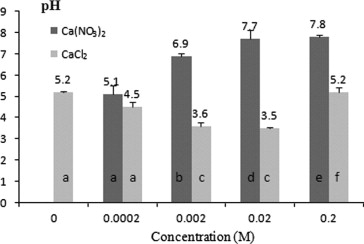
Fig. pH values of media with different levels of Ca(NO3)2 and CaCl2 after one month of cultivation of Alternaria sp. For each analyte, bars with the same letters are not significantly different (p > 0.05).
Formation of CaCO3 induced by fungal physiological activities is a potential way to sequestrate atmospheric CO2 in ecosystem. Alternaria sp. is a saprophytic fungus isolated from a forest soil. We examined the precipitation of CaCO3 induced by the fungus in response to different levels of Ca(NO3)(2) or CaCl2 in agar media, and the biogenesis of CaCO3 was verified by low delta C-13 value. The formed CaCO3 was identified as calcite by X-ray diffraction analysis. Square, rectangular and rhombic CaCO3 crystals and amorphous calcium carbonate were observed around mycelia at higher levels of Ca(NO3)(2). Acidification occurred in media at low concentrations (0 and 0.0002 M) of Ca(NO3)(2), and no CaCO3 formed in these media. The quantities of CaCO3 formed in media increased with increasing concentrations of Ca(NO3)(2) and were significantly correlated to fungal biomass, pH value and nitrite concentrations. No CaCO3 was formed in media with CaCl2 at all levels. These results collectively indicated that the formation of CaCO3 can be induced by the fungal assimilation of nitrate. The study also revealed that biogenic crystal of CaCO3 tended to grow on a silicon nucleus and the amorphous calcium carbonate (ACC) was the transient stage of CaCO3 crystal. (C) 2010 Elsevier Ltd. All rights reserved.
| Publication name |
BIORESOURCE TECHNOLOGY Volume: 102 Issue: 2 Pages: 1562-1566 Published: JAN 2011 |
| Author(s) |
Hou, Weiguo, Lian, Bin, Zhang, Xiaoqing |
| Corresponding author |
LIAN Bin
bin2368@vip.163.com
Chinese Acad Sci, State Key Lab Environm Geochem, Inst Geochem, Guiyang 550002, Peoples R China |
View here for full text from the publisher